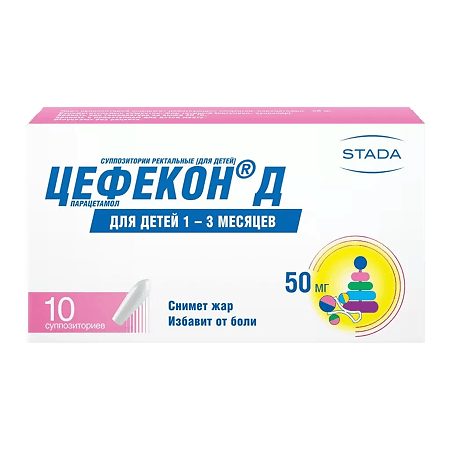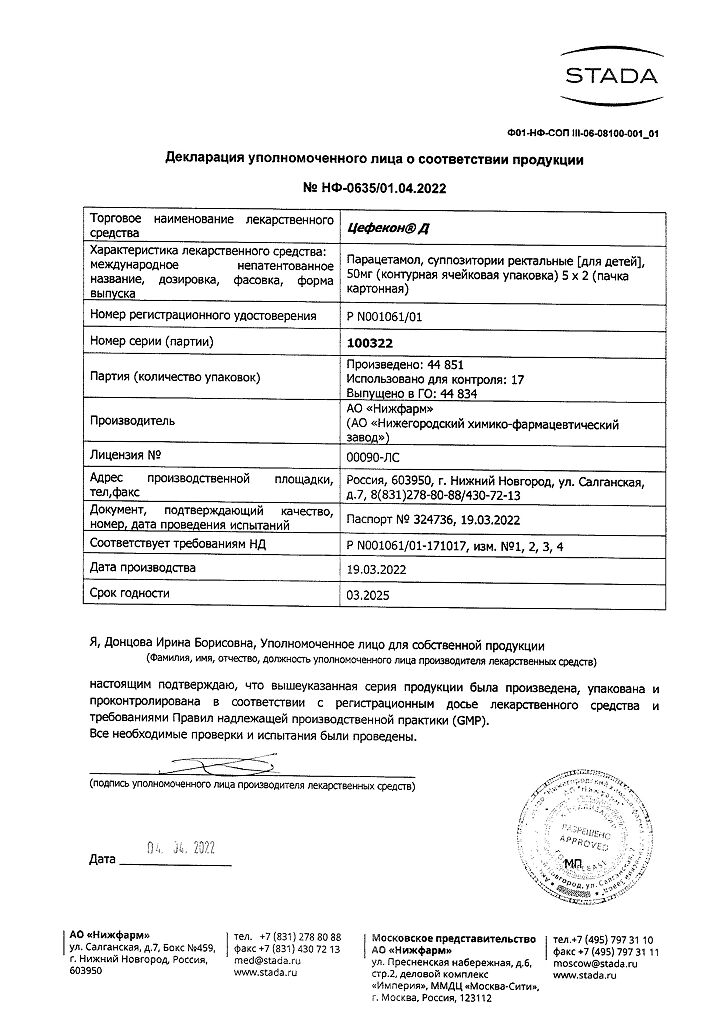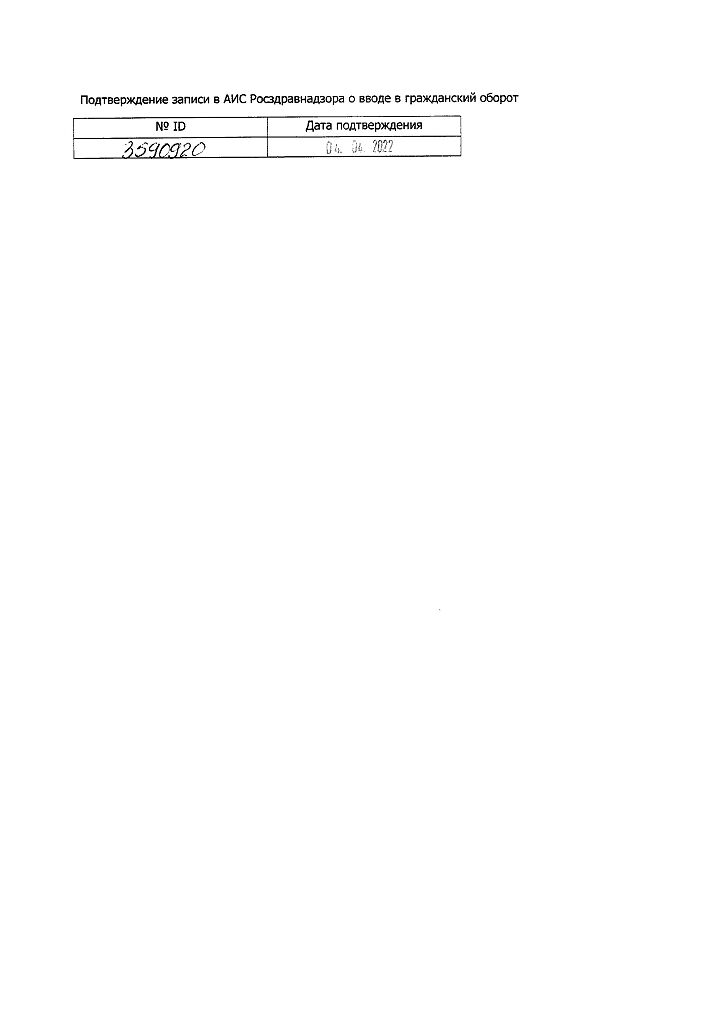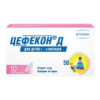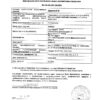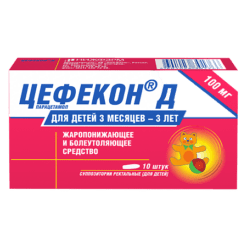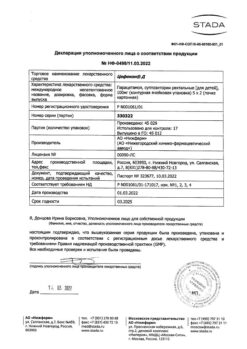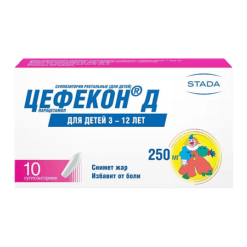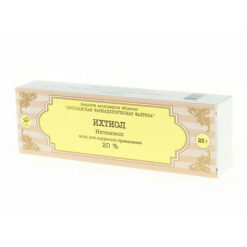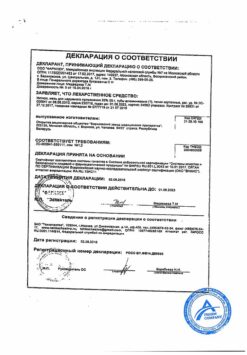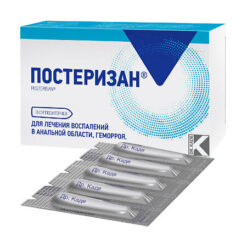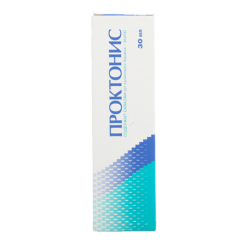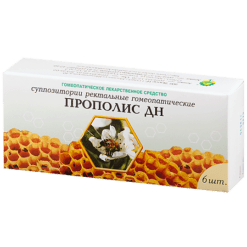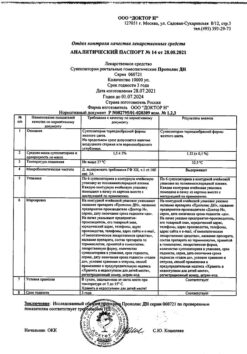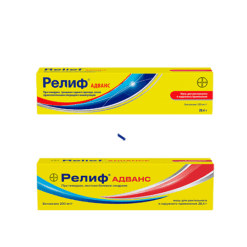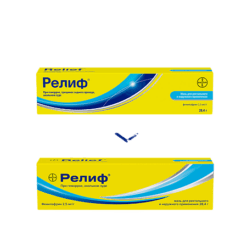No products in the cart.
Cefecon D for children, rectal 50 mg 10 pcs
€0.96 €0.87
Description
It has analgesic and antipyretic effect. It blocks cyclooxygenase in CNS, affecting the centers of pain and thermoregulation.
In the focus of inflammation, cellular peroxidases neutralize the effect of paracetamol on cyclooxygenase, which explains the lack of significant anti-inflammatory action.
The drug has no negative effect on water-electrolyte metabolism (does not lead to sodium and water retention) and gastrointestinal mucosa.
Pharmacokinetics
Intake and distribution
It is quickly and highly absorbed from the gastrointestinal tract. Cmax is reached after 30-60 min. Binding to plasma proteins is 15%. It penetrates through the HEB.
Metabolism and excretion
Metabolized in the liver; 80% reacts with glucuronic acid and sulfates to form inactive metabolites; 17% undergoes hydroxylation to form active metabolites, which then conjugate with glutathione to form inactive metabolites.
In glutathione deficiency these metabolites can block the enzyme systems of hepatocytes and cause their necrosis. T1/2 is 2-3 h. Within 24 hours, 85-95% of paracetamol is excreted by the kidneys as glucuronides and sulfates, 3% is unchanged.
Pharmacokinetics in special clinical cases
Vd and bioavailability in children (including infants) are similar to those in adults. In infants of the first 2 days of life and in children aged 3-10 years, the main metabolite of paracetamol is paracetamol sulfate; in children 12 years and older – conjugated glucuronide.
There is no significant age difference in the elimination rate of paracetamol and in the total amount of the drug excreted in the urine.
Indications
Indications
The drug is intended for use in children aged 3 months to 12 years.
In children aged 1 to 3 months, a single use of the drug is possible to reduce fever after vaccination (the possibility of using the drug for other indications is decided by the doctor individually).
Used as:
antipyretic for acute respiratory viral infections, influenza, childhood infections, post-vaccination reactions and other conditions accompanied by an increase in body temperature;
an analgesic for pain of mild to moderate intensity, including: headache, toothache, muscle pain, neuralgia, pain from injuries and burns.
Pharmacological effect
Pharmacological effect
Has an analgesic and antipyretic effect. Blocks cyclooxygenase in the central nervous system, affecting pain and thermoregulation centers.
At the site of inflammation, cellular peroxidases neutralize the effect of paracetamol on cyclooxygenase, which explains the lack of significant anti-inflammatory effect.
The drug does not have a negative effect on water-electrolyte metabolism (does not lead to sodium and water retention) and the gastrointestinal mucosa.
Pharmacokinetics
Suction and distribution
Quickly and highly absorbed from the gastrointestinal tract. Cmax is reached within 30-60 minutes. Plasma protein binding – 15%. Penetrates through the BBB.
Metabolism and excretion
Metabolized in the liver; 80% reacts with glucuronic acid and sulfates to form inactive metabolites; 17% undergoes hydroxylation to form active metabolites, which are then conjugated with glutathione to form inactive metabolites.
With a lack of glutathione, these metabolites can block the enzyme systems of hepatocytes and cause their necrosis. T1/2 – 2-3 hours. Within 24 hours, 85-95% of paracetamol is excreted by the kidneys in the form of glucuronides and sulfates, unchanged – 3%.
Pharmacokinetics in special clinical situations
Vd and bioavailability in children (including newborns) are similar to those in adults. In newborns of the first 2 days of life and in children aged 3-10 years, the main metabolite of paracetamol is paracetamol sulfate, in children 12 years and older – conjugated glucuronide.
There is no significant age-related difference in the rate of elimination of paracetamol and in the total amount of the drug excreted in the urine.
Special instructions
Special instructions
The patient should be warned about the need to consult a doctor if fever persists for more than 3 days and pain persists for more than 5 days.
Concomitant use with other paracetamol-containing drugs should be avoided, because this may cause an overdose of paracetamol.
When using the drug for more than 5-7 days, peripheral blood counts and the functional state of the liver should be monitored. Paracetamol distorts laboratory results in the quantitative determination of glucose and uric acid in plasma.
For impaired renal function
Use the drug with caution in case of impaired renal function.
For liver dysfunction
Use the drug with caution in case of liver dysfunction.
Active ingredient
Active ingredient
Paracetamol
Composition
Composition
One suppository contains:
Active substance:
Paracetamol – 50 mg, 100 mg or 250 mg;
Basics for suppositories:
Solid fat (vitepsol, supposir) – until a suppository weighing 1.25 g is obtained.
Pregnancy
Pregnancy
Use with caution during pregnancy, breastfeeding and children under 3 months of age.
Contraindications
Contraindications
Hypersensitivity, neonatal period (up to 1 month).
With caution
Renal and liver failure, benign hyperbilirubinemia (including Gilbert’s syndrome), viral hepatitis, alcoholic liver damage, alcoholism, pregnancy, lactation, genetic absence of glucose-6-phosphate dehydrogenase, concomitant use of other paracetamol-containing drugs.
Side Effects
Side Effects
From the digestive system: nausea, vomiting, abdominal pain are possible.
Allergic reactions: rash on the skin and mucous membranes, itching, urticaria, Quincke’s edema.
From the hematopoietic system: rarely – anemia, thrombocytopenia, leukopenia, agranulocytosis.
With long-term use in high doses, the development of hepatotoxic and nephrotoxic (interstitial nephritis and papillary necrosis) effects, hemolytic anemia, aplastic anemia, methemoglobinemia, pancytopenia is possible.
Interaction
Interaction
Inducers of microsomal oxidation in the liver (phenytoin, ethanol, barbiturates, flumecinol, rifampicin, phenylbutazone, tricyclic antidepressants), ethanol, hepatotoxic drugs increase
production of hydroxylated active metabolites, which makes it possible to develop severe intoxication even with a slight overdose.
Microsomal oxidation inhibitors (cimetidine) reduce the risk of hepatotoxicity.
When taken simultaneously with salicylates, the likelihood of developing nephrotoxicity increases.
When used together with paracetamol, the toxic effects of chloramphenicol are enhanced.
When used together with paracetamol, the effect of indirect anticoagulants is enhanced and the effectiveness of uricosuric drugs is reduced.
Overdose
Overdose
Symptoms:
during the first 24 hours after administration – pallor of the skin, nausea, vomiting, anorexia, abdominal pain; impaired glucose metabolism, metabolic acidosis.
Symptoms of liver dysfunction may appear 12-48 hours after an overdose.
In case of severe overdose – liver failure with progressive encephalopathy, coma, death; acute renal failure with tubular necrosis (including in the absence of severe liver damage); arrhythmia, pancreatitis. The hepatotoxic effect in adults occurs when taking 10 g or more.
Treatment:
administration of SH-group donors and precursors for the synthesis of glutathione – methionine 8-9 hours after an overdose and N-acetylcysteine - after 12 hours.
The need for further therapeutic measures (further administration of methionine, intravenous administration of N-acetylcysteine) is determined depending on the concentration of paracetamol in the blood, as well as the time elapsed after its administration.
Storage conditions
Storage conditions
In a dry place, at a temperature not exceeding 20 °C
Shelf life
Shelf life
3 years
Manufacturer
Manufacturer
Nizhpharm JSC, Russia
Additional information
| Shelf life | 3 years |
|---|---|
| Conditions of storage | In a dry place, at a temperature no higher than 20 °C |
| Manufacturer | Nizhpharm AO, Russia |
| Medication form | rectal suppositories |
| Brand | Nizhpharm AO |
Other forms…
Related products
Buy Cefecon D for children, rectal 50 mg 10 pcs with delivery to USA, UK, Europe and over 120 other countries.

